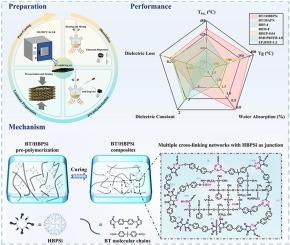Hyperbranched polysiloxane junction points with dual roles in multi-crosslinked BT resin networks: Synergistic engineering of ultrahigh toughness, dielectric performance, and thermal stability
IF 4.5
2区 化学
Q2 POLYMER SCIENCE
引用次数: 0
Abstract
Microelectronics is rapidly advancing toward miniaturization and high-density integration. Consequently, there is a growing demand for structural-functional integrated materials with excellent comprehensive properties, particularly in cutting-edge applications like printed circuit boards. In this work, a hyperbranched polysiloxane (HBPSi) was synthesized and incorporated into a bismaleimide-triazine (BT) resin matrix. The modified bismaleimide-triazine (BT) resin features a multi-crosslinked network with HBPSi as junctions. Benefiting from the dual-role synergy of amino groups and hyperbranched architecture of HBPSi, the modified BT resin demonstrates exceptional thermal stability, significantly enhanced hydrophobicity, a low dielectric constant of 3.21 and dielectric loss of 0.016 (at 1 MHz), showing great potential for electronic applications. Based on this, the structural-functional integrated composites by incorporating aramid fiber reinforcement were fabricated. These composites not only exhibit outstanding mechanical properties (impact strength exceeding 100 kJ/m2) but also maintain excellent dielectric performance. This research establishes a simple yet effective method for manufacturing high-performance structural-functional integrated dielectric materials, thereby expanding their potential applications in next-generation electronic devices.


在多重交联BT树脂网络中具有双重作用的超支化聚硅氧烷结点:超高韧性、介电性能和热稳定性的协同工程
微电子学正迅速向小型化和高密度集成化方向发展。因此,对具有优异综合性能的结构功能集成材料的需求不断增长,特别是在印刷电路板等尖端应用中。本文合成了超支化聚硅氧烷(HBPSi),并将其掺入双马来酰亚胺-三嗪(BT)树脂基体中。改性双马来酰亚胺-三嗪(BT)树脂具有以HBPSi为结的多交联网络。得益于氨基的双作用协同作用和HBPSi的超支化结构,改性后的BT树脂具有优异的热稳定性,显著增强了疏水性,介电常数为3.21,介电损耗为0.016 (1 MHz),具有很大的电子应用潜力。在此基础上,制备了芳纶纤维增强的结构-功能一体化复合材料。这些复合材料不仅具有优异的机械性能(冲击强度超过100 kJ/m2),而且具有优异的介电性能。本研究建立了一种简单而有效的制造高性能结构功能集成介电材料的方法,从而扩大了其在下一代电子器件中的潜在应用。
本文章由计算机程序翻译,如有差异,请以英文原文为准。
求助全文
约1分钟内获得全文
求助全文
来源期刊

Polymer
化学-高分子科学
CiteScore
7.90
自引率
8.70%
发文量
959
审稿时长
32 days
期刊介绍:
Polymer is an interdisciplinary journal dedicated to publishing innovative and significant advances in Polymer Physics, Chemistry and Technology. We welcome submissions on polymer hybrids, nanocomposites, characterisation and self-assembly. Polymer also publishes work on the technological application of polymers in energy and optoelectronics.
The main scope is covered but not limited to the following core areas:
Polymer Materials
Nanocomposites and hybrid nanomaterials
Polymer blends, films, fibres, networks and porous materials
Physical Characterization
Characterisation, modelling and simulation* of molecular and materials properties in bulk, solution, and thin films
Polymer Engineering
Advanced multiscale processing methods
Polymer Synthesis, Modification and Self-assembly
Including designer polymer architectures, mechanisms and kinetics, and supramolecular polymerization
Technological Applications
Polymers for energy generation and storage
Polymer membranes for separation technology
Polymers for opto- and microelectronics.
 求助内容:
求助内容: 应助结果提醒方式:
应助结果提醒方式:


